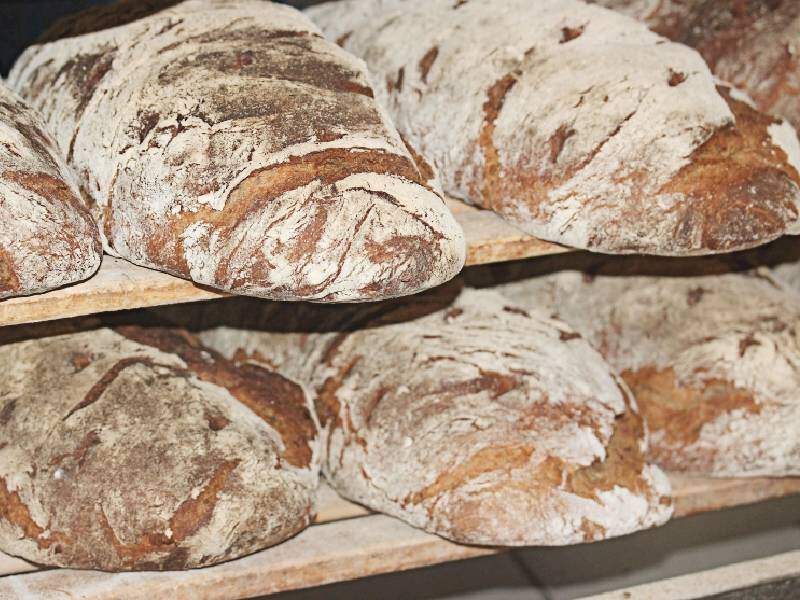Flour is a versatile cooking and baking ingredient made by finely grinding wheat, rye, barley, rice or maize. Many types of flour are available, with different countries having unique labelling systems.
If you’re looking for all-purpose flour but can only find plain or baker’s flour, can you use them? What is all-purpose flour? And how about self-raising or self-rising flour? What are the differences?
I’ll help you answer your flour-related questions, just read on!

A guide on the common types of flour
Flour is what gives baked goods their shape and texture. The proteins found in wheat flour bond to produce a gluten network that traps the gas produced in leavened bread, cakes and pastries.
What is all-purpose flour?
All-purpose flour is a type of flour that can be used for almost any type of baked good. Containing between 50-75% of the original wheat kernel, all-purpose flour’s low to medium protein content makes it a perfect all-rounder.
In the UK, All-Purpose flour is called Plain Flour. Both are milled from both hard and soft wheat and have a medium to low protein content.
If you are following a recipe that calls for all-purpose flour, plain flour can be used.
All-purpose vs. plain flour
There are slight differences between all-purpose and plain flour.
In the US, flour is often sourced from Canada and northern states. Wheat grown in these climates generally produces flour with a higher protein content than UK flour.
As US flour usually contains more protein than UK flour, bread bakers enjoy better results with all-purpose flour. In the UK, plain flour is rarely used to make bread.
Bleaching all-purpose flour
In the US, flour is often bleached with a chemical such as benzoyl peroxide, potassium bromate and chlorine gas. Bleaching ages the flour, thus reducing storage costs and lowering production costs.
Whilst the seriousness of the nutritional impact of bleaching flour has long been contested, there are some notable differences in how bleach vs non-bleached flour behaves.
Bleaching whitens the flour’s colour but brightens the baked goods’ colour. The process results in finer and softer textured grain particles.
Products made with bleached flour are softer and have a lighter, more voluminous texture. There is a key trade-off, however, which is being less flavoursome.
All-purpose flour nutrition
All-purpose flour is a fantastic source of protein and other vital nutrients. It’s a good source of selenium, riboflavin, niacin, and thiamine. Traceable amounts of copper, iron, phosphorus, and zinc are also present.
It lacks the healthy fibre that whole wheat flour contains, but it makes up for this in versatility!
All-purpose flour calories
The flour nutrition labels indicate that a single cup provides about 455 calories. It may seem a lot, but you’re not likely to consume that many calories. Because when you mix flour with liquids and other ingredients to make your food or bread, fewer calories are consumed.
Self-raising flour
This type of flour is all-purpose flour mixed with baking powder. Including the leavening agent in the flour makes measuring the perfect quantities for your light and fluffy cakes easier.
Self-rising flour vs. self-raising flour
Like all-purpose and plain flour, self-rising and self-raising are different names for the same type of flour. Self-rising is commonly used in the UK, while self-raising is used in the US.
How do you make 200g plain flour into self-rising?
If your recipe requires self-rising flour, you can easily make your own at home! Add half a teaspoon of baking powder to every 100g of plain flour and dry-mix it. So, if you need 200g of self-rising flour, you can add a teaspoon of baking powder to plain flour.
What is pastry flour?
Pastry flour is milled to a finer texture than all-purpose. It is made from a softer wheat, often with a lower protein content.
Pastry flour produces a very tender crumb with a fine crumb structure, great for croissants, puff pastry, pie crusts and pound cakes. In France, pastry flour is known as T45.
What is cake flour?
Cake flour is the best for making light and fluffy cakes. It only has around 5% protein content, which is the lowest compared to other flours.
Baked products made with low-protein flour are lighter and less chewy, making cake flour perfect for making cakes.
What makes bread flour, bread flour?
Bread flour has the highest protein content. It’s milled mainly from hard wheat, producing a higher protein flour and developing a more robust gluten structure.
Bread made with higher protein flour will capture more gases during proofing, requiring less kneading. It’s ideal for making quickly-risen bread and ensures the bread rises higher.
How do you turn all-purpose flour into bread flour?
If your recipe calls for bread flour, but you’ve run out, you can substitute it with all-purpose flour for reasonable results.
To increase the gluten content and turn all-purpose flour into bread flour, remove one teaspoon of flour and replace it with one teaspoon of vital wheat gluten.
00 flour – what’s the difference?
00 flour is an Italian-milled flour that’s best used for making pasta and pizza dough. This is a fine flour that creates a dough that’s silkier and light.
It’s perfect for pasta as well as long-fermented Italian bread. Its protein content is about 11-12%, slightly higher than all-purpose flour.

What is ciabatta flour?
Ciabatta flour is a coarse and rustic flour that originates from Northern Italy.
Its super high protein of around 14% supports the large air bubbles that develop during a long, cold fermentation period.
Ciabatta flour is made to be used for ciabatta bread, this flour works well in many high-hydration doughs.
Do I need pizza flour to make pizza?
Pizza flour is a type of 00 flour. This is white bread flour with high gluten content, specifically chosen for its extensibility after a long rising period.
The specific pizza flour chosen determines how long pizza dough can last in the fridge or ferment at room temperature.
The combination of high extensibility and soft wheat produces pizza dough that retains its shape, develops flavour and “puffs up” just the right amount in the oven.
What is “enriched flour”?
This flour has been fortified with minerals. Some minerals, fibres, and vitamins are extracted when wheat is milled. Due to government legislation, some of these minerals are being added back with enriched flour.
What is wholemeal flour?
Wholemeal flour is the UK term for whole wheat flour. It contains up to 100% of the wheat grain, with more fibre, more complex carbohydrates and a higher amount of nutrients than white flour.
Perfect to make brown bread, wholemeal bread, and soda bread.
Typical flour protein content
| Flour Type | Typical Protein Content |
| High strength bread flour | 13 – 15% |
| Pizza flour | 11.5 – 14.5% |
| Standard bread flour | 11.5 – 13% |
| All-purpose flour | 9 – 12% |
| Plain flour | 9 – 11% |
| Pastry flour | 9 – 11% |
| Cake flour | 9 – 10 % |
Frequently asked questions about flour
If you’ve enjoyed this article and wish to treat me to a coffee, you can by following the link below – Thanks x

Hi, I’m Gareth Busby, a baking coach, senior baker and bread-baking fanatic! My aim is to use science, techniques and 15 years of baking experience to make you a better baker.
Table of Contents
- A guide on the common types of flour
- What is all-purpose flour?
- All-purpose vs. plain flour
- Bleaching all-purpose flour
- Self-raising flour
- How do you make 200g plain flour into self-rising?
- What is pastry flour?
- What is cake flour?
- What makes bread flour, bread flour?
- How do you turn all-purpose flour into bread flour?
- 00 flour – what’s the difference?
- What is ciabatta flour?
- Do I need pizza flour to make pizza?
- What is “enriched flour”?
- What is wholemeal flour?
- Typical flour protein content
- Frequently asked questions about flour
Related Recipes
Related Articles
Latest Articles
Baking Categories
Disclaimer
Address
53 Greystone Avenue
Worthing
West Sussex
BN13 1LR
UK









